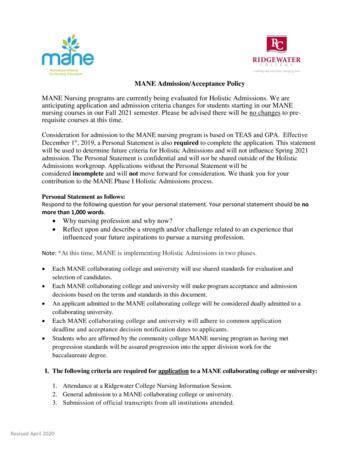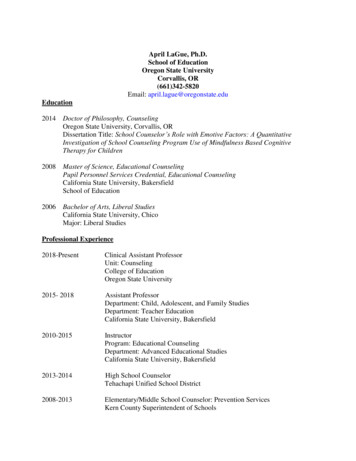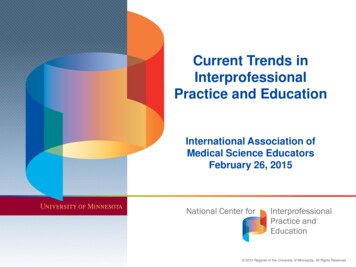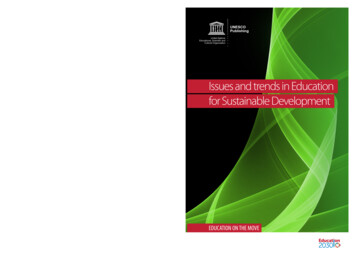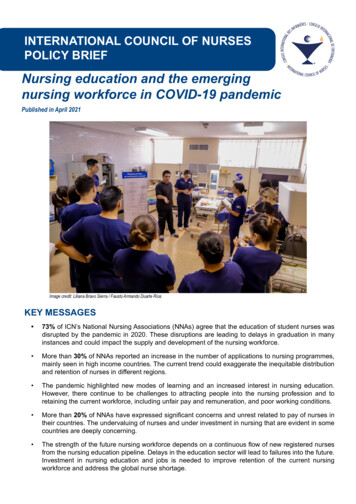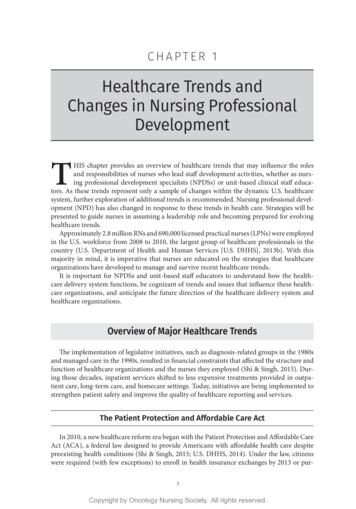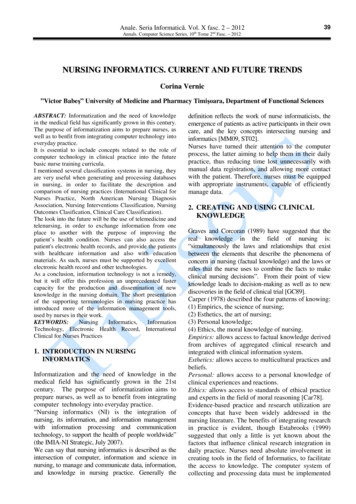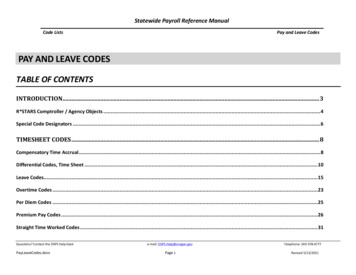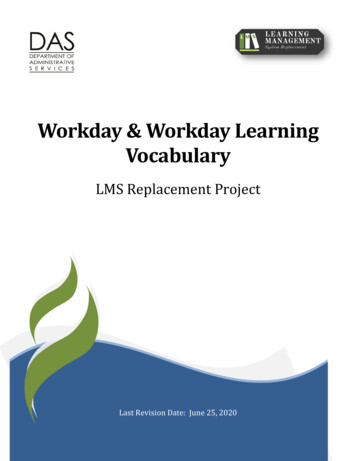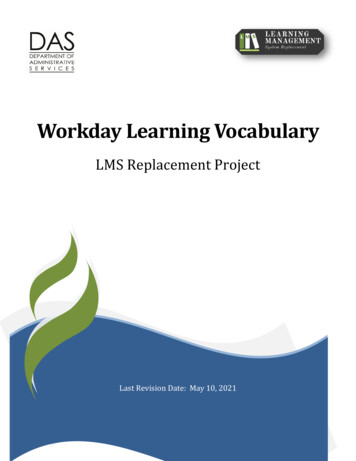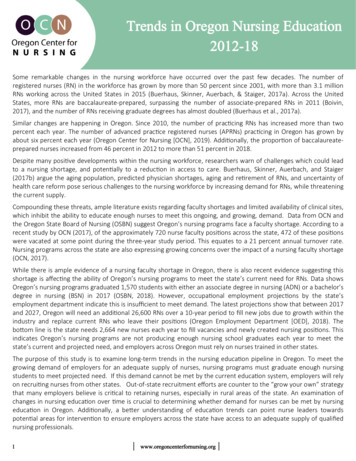
Transcription
Trends in Oregon Nursing Education2012-18Some remarkable changes in the nursing workforce have occurred over the past few decades. The number ofregistered nurses (RN) in the workforce has grown by more than 50 percent since 2001, with more than 3.1 millionRNs working across the United States in 2015 (Buerhaus, Skinner, Auerbach, & Staiger, 2017a). Across the UnitedStates, more RNs are baccalaureate‐prepared, surpassing the number of associate‐prepared RNs in 2011 (Boivin,2017), and the number of RNs receiving graduate degrees has almost doubled (Buerhaus et al., 2017a).Similar changes are happening in Oregon. Since 2010, the number of prac cing RNs has increased more than twopercent each year. The number of advanced prac ce registered nurses (APRNs) prac cing in Oregon has grown byabout six percent each year (Oregon Center for Nursing [OCN], 2019). Addi onally, the propor on of baccalaureate‐prepared nurses increased from 46 percent in 2012 to more than 51 percent in 2018.Despite many posi ve developments within the nursing workforce, researchers warn of challenges which could leadto a nursing shortage, and poten ally to a reduc on in access to care. Buerhaus, Skinner, Auerbach, and Staiger(2017b) argue the aging popula on, predicted physician shortages, aging and re rement of RNs, and uncertainty ofhealth care reform pose serious challenges to the nursing workforce by increasing demand for RNs, while threateningthe current supply.Compounding these threats, ample literature exists regarding faculty shortages and limited availability of clinical sites,which inhibit the ability to educate enough nurses to meet this ongoing, and growing, demand. Data from OCN andthe Oregon State Board of Nursing (OSBN) suggest Oregon’s nursing programs face a faculty shortage. According to arecent study by OCN (2017), of the approximately 720 nurse faculty posi ons across the state, 472 of these posi onswere vacated at some point during the three‐year study period. This equates to a 21 percent annual turnover rate.Nursing programs across the state are also expressing growing concerns over the impact of a nursing faculty shortage(OCN, 2017).While there is ample evidence of a nursing faculty shortage in Oregon, there is also recent evidence sugges ng thisshortage is affec ng the ability of Oregon’s nursing programs to meet the state’s current need for RNs. Data showsOregon’s nursing programs graduated 1,570 students with either an associate degree in nursing (ADN) or a bachelor’sdegree in nursing (BSN) in 2017 (OSBN, 2018). However, occupa onal employment projec ons by the state’semployment department indicate this is insufficient to meet demand. The latest projec ons show that between 2017and 2027, Oregon will need an addi onal 26,600 RNs over a 10‐year period to fill new jobs due to growth within theindustry and replace current RNs who leave their posi ons (Oregon Employment Department [OED], 2018). Thebo om line is the state needs 2,664 new nurses each year to fill vacancies and newly created nursing posi ons. Thisindicates Oregon’s nursing programs are not producing enough nursing school graduates each year to meet thestate’s current and projected need, and employers across Oregon must rely on nurses trained in other states.The purpose of this study is to examine long‐term trends in the nursing educa on pipeline in Oregon. To meet thegrowing demand of employers for an adequate supply of nurses, nursing programs must graduate enough nursingstudents to meet projected need. If this demand cannot be met by the current educa on system, employers will relyon recrui ng nurses from other states. Out‐of‐state recruitment efforts are counter to the “grow your own” strategythat many employers believe is cri cal to retaining nurses, especially in rural areas of the state. An examina on ofchanges in nursing educa on over me is crucial to determining whether demand for nurses can be met by nursingeduca on in Oregon. Addi onally, a be er understanding of educa on trends can point nurse leaders towardspoten al areas for interven on to ensure employers across the state have access to an adequate supply of qualifiednursing professionals.1 www.oregoncenterfornursing.org
Practical Nursing ProgramsLicensed prac cal nurses (LPNs) provide basic medical care to pa ents under the direc on of registered nurses andlicensed independent prac oners. Those with an interest in becoming a Licensed Prac cal Nurse o en complete ayear‐long prac cal nursing program prior to being licensed by a state. In Oregon, prac cal nursing programs areusually housed within a community or technical college. In 2018, there were nine prac cal nursing programsopera ng at seven schools. The number of programs within the state has not changed markedly since 2012 (Table 1).Table 1 Practical Nursing Programs in OregonWhile the number of programs remained fairly constant over me, data show the number of faculty members variedgreatly from one year to the next. However, close examina on of original school reports suggests this may be arepor ng issue, and these figures likely do not accurately represent the number of faculty teaching in Oregon’sprac cal nursing programs.Table 2 Student Enrollment in Practical Nursing ProgramsOregon’s prac cal nursing programs received about 780 applica ons per year and about 70 percent of applicantswere admi ed (Table 2). About 500 PN students enrolled in programs yearly. Approximately 400 students graduatedeach year. School reports showed a 20 percent decrease in the number of budgeted seats between 2012 and 2015.Enrollment showed signs of declining early during the period of study but rebounded somewhat beginning in 2016.The large drop in enrollment seen in 2014 was due to the closing of the largest prac cal nursing program in the state.Similarly, the number of graduates declined markedly over me, but recently showed signs of increasing.Table 3 Percent of Female Students and Graduates - Practical Nursing Programs2 www.oregoncenterfornursing.org
While gender diversity (Table 3) among students did not differ from the composi on of the licensed LPN workforce,data examining racial/ethnic makeup showed prac cal nursing students were more diverse than licensed LPNs(Table 4). Enrollment and graduate percentages for Hispanic and black students rose no ceably over the past sixyears. In 2012, Hispanic students accounted for a li le more than five percent of enrolled students. This grew toalmost eight percent by 2018. Similarly, Hispanics comprised about three percent of graduates in 2012, but this morethan doubled by 2018. The percent of black students enrolled quadrupled and the percent of black graduates tripledover the past seven years. Other racial groups showed li le change. While this result appears to suggest prac calnursing programs are becoming more diverse, some of this change could be due to repor ng issues and a markeddecrease in the percent of the students repor ng an unknown racial/ethnic iden ty since 2012.Table 4 Race/Ethnicity of Practical Nursing StudentsStudents enrolled and gradua ng from prac cal nursing programs tend to be in their 20s (Table 5). The agedistribu on of prac cal nursing program graduates con nued this trend as 50 percent of 2012 graduates and 58percent of 2018 graduates were 30 years‐of‐age or younger. Very few prac cal nursing students and graduates wereover the age of 50.Table 5 Age of Practical Nursing Students and Graduates3 www.oregoncenterfornursing.org
Associate Degree ProgramsProspec ve registered nurses have a choice when deciding upon their educa onal path to become a licensed RN inOregon. One op on is an associate degree in nursing offered at community and technical colleges throughout thestate. Comple on of an ADN degree, including prerequisite classes, takes about three years, and includes classes innursing theory, nursing prac ce, as well as clinical instruc on.There are currently 17 ADN nursing programs in Oregon, a number that remained constant over the study period(Table 6).Table 6 Associate Degree Nursing Programs in OregonWhile the number of nursing programs has not changed over me, interest in ADN programs may be declining. Thenumber of budgeted seats decreased over me and could be indica ve of shrinking capacity across ADN nursingprograms in Oregon (Table 7). Despite early increases in enrollment and graduate numbers, enrollment has declinedby 15 percent since 2014 and graduates dropped by 11 percent. Similarly, admissions decreased by 14 percent since2014. The number of applica ons received for admi ance to ADN programs has declined slightly, although there wasa small increase in 2018. It is unclear if this increase is an anomaly or a step in a trend of increasing applica ons.Table 7 Student Enrollment in Associate Degree Nursing ProgramsAn examina on of demographic variables of ADN nursing program students indicates ADN students were slightlymore diverse than licensed RNs. In 2018, about 86 percent of licensed RNs were female. Collec vely, ADN programshad a slightly higher percentage of males (Table 8).Table 8 Percent of Female Students and Graduates - Associate Degree Nursing Programs4 www.oregoncenterfornursing.org
Data also suggest the student body enrolled in ADN nursing programs are becoming more racially diverse (Table 9).When comparing race/ethnicity from 2012 and 2018, the propor on of white students and graduates declined whilethe propor on of Hispanic students increased. However, the increase in the unknown race category may mask smallchanges in race/ethnicity distribu on in 2018. This is especially true when examining the racial composi on of ADNprogram graduates because the propor on of students repor ng an unknown race/ethnicity increased from sevenpercent in 2012 to about 20 percent in 2018.Table 9 Race/Ethnicity of Associate Degree Nursing StudentsThe 2018 student body was slightly younger (Table 10). In 2012, about 47 percent of enrolled students were age 30 oryounger, while about 53 percent were 31 years‐of‐age or older. In 2018, 56 percent were age 30 or younger and 44percent were 31 or older. This same pa ern emerges when examining the age distribu on of ADN graduates. It isencouraging to see a younger student body enrolled in and gradua ng from ADN programs as it increases the numberof younger RNs entering the workforce. It is possible the older cohort observed in 2012 was due to effects of theeconomic downturn of 2007‐2008, as more older students enrolled in nursing schools.Table 10 Age of Associate Degree Nursing Students and Graduates5 www.oregoncenterfornursing.org
Bachelor’s Degree ProgramsAnother path to becoming a registered nurse is to enroll in a four‐year college or university to earn a Bachelor ofScience in Nursing degree. A tradi onal BSN program takes about 4 years to complete. In Oregon, there are sixschools that confer BSN degrees. One school, Oregon Health and Sciences University (OHSU), operates programs atfive campuses across the state, which is why the number of BSN programs is more than double the number of schools(Table 11).Table 11 Bachelor’s Degree Nursing Programs in OregonDuring the period studied, BSN programs grew (Table 12). The number of applica ons for BSN programs increased by11 percent from 2012 to 2018. BSN programs responded, increasing their annual capacity. The number of budgetedseats increased 28 percent since 2012. Enrollment, the number of students admi ed, and the number of studentsgradua ng also increased from 2012 to 2018.Table 12 Student Enrollment in Bachelor’s Degree Nursing ProgramsWhen examining the gender mix of BSN students and graduates, it is clear these students mirror the gendercomposi on of the licensed workforce in Oregon (Table 13). While the propor on of males in the licensed RNworkforce slowly increased (about two percent points since 2012), there is li le indica on the gender mix of the BSNstudent body is changing over me.Table 13 Percent of Female Students and Graduates - Bachelor’s Degree Nursing Programs6 www.oregoncenterfornursing.org
While the gender mix among BSN students remained constant, it is clear the BSN student body became more diverseover me, and was more diverse than the 2018 licensed RN workforce. In 2018, about 70 percent of licensed RNswere white, three percent were Hispanic, and four percent were Asian. Within BSN programs, Hispanic and Asianstudents were present in higher propor ons than the workforce and made gains in the student popula on comparedto the distribu on in 2012 (Table 14). This is promising as the current workforce is less diverse than the popula on ofOregon. Increases in the diversity of nursing students may accelerate the diversity of the workforce over me.Table 14 Race/Ethnicity of Bachelor’s Degree Nursing StudentsStudents enrolled in BSN programs were markedly younger than those enrolled in ADN programs (Table 10 and 15 fordirect comparisons). In 2018, 82 percent of BSN enrollees were 30 years‐of‐age or younger, while only 56 percent ofADN students were in this age range. Also, the BSN student body was younger in 2018 than they were in 2012, 82percent and 73 percent, respec vely. A similar trend was observed for graduates from BSN programs. Aboutthree‐quarters (74 percent) of students graduated before their 31st birthday, compared to 54 percent for ADNprogram graduates. Addi onally, BSN program graduates who graduated in 2018 were younger than BSN programstudents gradua ng in 2012 where 65 percent graduated prior to their 31st birthday. This is consistent with previousrepor ng (OCN, 2018a) showing a markedly younger RN workforce than in previous years.Table 15 Age of Bachelor’s Degree Nursing Students and Graduates7 www.oregoncenterfornursing.org
Optional Pathways to Baccalaureate DegreesStudents not interested in a tradi onal 4‐year baccalaureate degree have alterna ve op ons available to them.Students with a bachelor’s degree in a different field may enroll i
Trends in Oregon Nursing Education 2012-18 Some remarkable changes in the nursing workforce have occurred over the past few decades. The number of registered nurses (RN) in the workforce has grown by more than 50 percent since 2001, with more than 3.1 million RNs working across the United States in 2015 (Buerhaus, Skinner, Auerbach, & Staiger, 2017a). Across the United States, more RNs
